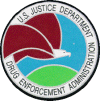|
 November
2000 November
2000
OPERATION LIBERATOR
On November 19, 2000,
the DEA concluded Operation Liberator, a multi-national regional operation,
whose primary objectives was to:
- Disrupt trafficking
activities in the Caribbean and South America region;
- Consolidate counterdrug
efforts in the Caribbean transit zone;
- Continue to develop
a comprehensive regional strategy; and
- Develop a cohesive/cooperative
environment among source and transit countries.
 |
| DEA
and local law enforcement carried out thousands of raids over the
three weeks of Operation Liberator. These raids were a major disruption
for a number of trafficking organizations. |
The operation, which
began on October 27, 2000, involved 33 countries. The DEA Caribbean Field
Division in Puerto Rico served as the coordination center for information
collection, collation, and dissemination. Additionally, the Unified Caribbean
On-line Regional Network (UNICORN) was used to facilitate the exchange
and dissemination of strategic, operational, and tactical information
to all participating law enforcement entities within the participating
countries. The DEA’s Santo Domingo and Port-au-Spain Country Offices
served as the northern and southern command centers for the duration of
the operation.
Thousands of searches
were carried out during three weeks of raids. Several of the individuals
arrested were leaders of major drug trafficking organizations, such as
Martires Pauline Castro, who was suspected of running a trafficking network
from St. Martin to New York, and shipping two tons of Colombian cocaine
to the United States each month.
Countries that collaborated
with DEA on this operation included Puerto Rico, Dominican Republic, Mexico,
Haiti, Ecuador, El Salvador, Venezuela, Bolivia, Panama, Belize, Honduras,
Suriname, St. Lucia, Guyana, Colombia, Honduras, Antigua, French Guyana,
Trinidad & Tobago, and the Caymen Islands.
|

